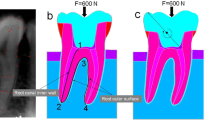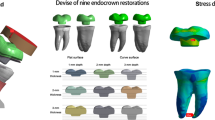Abstract
In order to investigate the influence of cusp reduction, cavity isthmus width, and restorative material on stress values in premolar with mesio-occlusal-distal (MOD) cavity, numerical simulations were done on three-dimensional (3D) models of a maxillary second premolar designed using computerized tomography (CT) scan images. The use of four restorative materials (direct resin composite, direct resin composite with resin-modified glass-ionomer cement as the base, indirect resin composite, ceramic), three cavity preparation designs (without cusp coverage, 2-mm palatal cusp coverage, 2-mm palatal and buccal cusp coverage), and two cavity isthmus widths (1/2 and 2/3 intercuspal width) were simulated. After applying a static load of 200 N on the occlusal surface of the tooth, von Mises stresses in the enamel, dentin, and restoration were calculated using finite element analysis (FEA). Stress values in the enamel were primarily influenced by cavity preparation design, while restorative material showed higher contribution in dentin. The lowest stress values were obtained in models with cusp coverage and indirect restorations. Cavity isthmus width had minimal influence on stress values in tooth structures. None of the investigated factors determined stress values in the restoration. In conclusion, the use of ceramic restoration covering both palatal and buccal cusp provided the most favourable stress distribution of premolars with MOD cavity.

ᅟ






Similar content being viewed by others
References
Deliperi S, Bardwell DN, Coiana C (2005) Reconstruction of devital teeth using direct fiber-reinforced composite resins: a case report. J Adhes Dent 7:165–171
González-López S, González-Villafranca MP, Bolaños-Carmona MV, Menéndez-Nuñez M (2009) A new approach to endodontic treatment and operative procedure in nonendodontically treated posterior crown root fractures. Oral Surg Oral Med Oral Pathol Oral Radiol Endod 108:e106–e110. https://doi.org/10.1016/j.tripleo.2009.06.014
Lin CL, Chang WJ, Lin YS, Chang YH, Lin YF (2009) Evaluation of the relative contributions of multi-factors in an adhesive MOD restoration using FEA and the Taguchi method. Dent Mater 25:1073–1081. https://doi.org/10.1016/j.dental.2009.01.105
Kantardžić I, Vasiljević D, Blažić L, Lužanin O (2012) Influence of cavity design preparation on stress values in maxillary premolar: a finite element analysis. Croat Med J 53:568–576
Yikilgan I, Bala O (2013) How can stress be controlled in endodontically treated teeth? A 3D finite element analysis. Scientific World Journal 2013:426134. https://doi.org/10.1155/2013/426134
Soares PV, Milito G, Pereira FA, Zéola LF, Naves MF, Faria VL, Machado AC, Souza PG, Reis BR (2013) Influence of geometrical configuration of the cavity in the stress distribution of restored premolars with composite resin. Journal of Research in Dentistry 1:72–82
Magne P, Knezevic A (2009) Thickness of CAD-CAM composite resin overlays influences fatigue resistance of endodontically treated premolars. Dent Mater 25:1264–1268. https://doi.org/10.1016/j.dental.2009.05.007
Mondelli J, Sene F, Ramos RP, Benetti AR (2007) Tooth structure and fracture strength of cavities. Braz Dent J 18:134–138
ElAyouti A, Serry MI, Geis-Gerstorfer J, Löst C (2011) Influence of cusp coverage on the fracture resistance of premolars with endodontic access cavities. Int Endod J 44:543–549. https://doi.org/10.1111/j.1365-2591.2011.01859.x
Lin CL, Chang YH, Liu PR (2008) Multi-factorial analysis of a cusp-replacing adhesive premolar restoration: a finite element study. J Dent 36:194–203. https://doi.org/10.1016/j.jdent.2007.11.016
Xie KX, Wang XY, Gao XJ, Yuan CY, Li JX, Chu CH (2012) Fracture resistance of root filled premolar teeth restored with direct composite resin with or without cusp coverage. Int Endod J 45:524–529. https://doi.org/10.1111/j.1365-2591.2011.02005.x
Lin CL, Chang CH, Ko CC (2001) Multifactorial analysis of an MOD restored human premolar using auto-mesh finite element approach. J Oral Rehabil 28:576–585
Gonzáles-López S, de Haro-Gasquet F, Vílchez-Díaz MÁ, Ceballos L, Bravo M (2006) Effect of restorative procedures and occlusal loading on cuspal deflection. Oper Dent 31:33–38
Fonseca RB, Fernandes-Neto AJ, Correr-Sobrinho L, Soares CJ (2007) The influence of cavity preparation design on fracture strength and mode of fracture of laboratory-processed composite resin restorations. J Prosthet Dent 98:277–284
Chang YH, Lin WH, Kuo WC, Chang CY, Lin CL (2009) Mechanical interactions of cuspal-coverage designs and cement thickness in a cusp-replacing ceramic premolar restoration: a finite element study. Med Biol Eng Comput 47:367–374. https://doi.org/10.1007/s11517-008-0379-y
Panahandeh N, Torabzadeh H, Ziaee N, Mahdian M, Tootiaee B, Ghasemi A (2017) The effect of composite thickness on the stress distribution pattern of restored premolar teeth with cusp reduction. J Prosthodont 26:440–445. https://doi.org/10.1111/jopr.12422
Soares PV, Santos-Filho PC, Martins LR, Soares CJ (2008) Influence of restorative technique on the biomechanical behavior of endodontically treated maxillary premolars. Part I: fracture resistance and fracture mode. J Prosthet Dent 99:30–37. https://doi.org/10.1016/S0022-3913(08)60006-2
Hannig C, Westphal C, Becker K, Attin T (2005) Fracture resistance of endodontically treated maxillary premolars restored with CAD/CAM ceramic inlays. J Prosthet Dent 94:342–349
Bitter K, Meyer-Lueckel H, Fotiadis N, Blunck U, Neumann K, Kielbassa AM, Paris S (2010) Influence of endodontic treatment, post insertion, and ceramic restoration on the fracture resistance of maxillary premolars. Int Endod J 43:469–477. https://doi.org/10.1111/j.1365-2591.2010.01701.x
Cubas GB, Habekost L, Camacho GB, Pereira-Cenci T (2011) Fracture resistance of premolars restored with inlay and onlay ceramic restoration and luted with two different agents. J Prosthodont Res 55:53–59. https://doi.org/10.1016/j.jpor.2010.07.001
Taha NA, Palamara JE, Messer HH (2011) Fracture strength and fracture patterns of root filled teeth restored with direct resin restorations. J Dent 39:527–535. https://doi.org/10.1016/j.jdent.2011.05.003
Vukicevic AM, Zelic K, Jovicic G, Djuric M, Filipovic N (2015) Influence of dental restorations and mastication loadings on dentine fatigue behaviour: image-based modelling approach. J Dent 43:556–567. https://doi.org/10.1016/j.jdent.2015.02.011
Ausiello P, Ciaramella S, Fabianelli A, Gloria A, Martorelli M, Lanzotti A, Watts DC (2017) Mechanical behavior of bulk direct composite versus block composite and lithium disilicate indirect class II restorations by CAD-FEM modeling. Dent Mater 33:690–701. https://doi.org/10.1016/j.dental.2017.03.014
Ausiello P, Ciaramella S, Garcia-Godoy F, Gloria A, Lanzotti A, Maietta S, Martorelli M (2017) The effect of cavity-margin-angles and bolus stiffness on the mechanical behavior of indirect resin composite class II restoration. Dent Mater 33:e39–e47. https://doi.org/10.1016/j.dental.2016.11.002
Dejak B, Mlotkowski A (2015) A comparison of stresses in molar teeth restored with inlays and direct restorations, including polymerization shrinkage of composite resin and tooth loading during mastication. Dent Mater 31:e77–e87. https://doi.org/10.1016/j.dental.2014.11.016
Chuang SF, Huang PS, Chen TYF, Huang LH, Su KC, Chang CH (2016) Shrinkage behaviors of dental composite restorations—the experimental-numerical hybrid analysis. Dent Mater 32:e362–e373 https://doi.org/10.1016/j.dental.2016.09.022
Plotino G, Buono L, Grande NM, Lamorgese V, Somma F (2008) Fracture resistance of endodontically treated molars restored with extensive composite resin restorations. J Prosthet Dent 99:225–232. https://doi.org/10.1016/S0022-3913(08)60047-5
Castañeda-Espinosa JC, Pereira RA, Cavalcanti AP, Mondelli RF (2007) Transmission of composite polymerization contraction force through a flowable composite and a resin-modified glass ionomer cement. J Appl Oral Sci 15:495–500
Taha NA, Palamara JE, Messer HH (2012) Assessment of laminate technique using glass ionomer and resin composite for restoration of root filled teeth. J Dent 40:617–623. https://doi.org/10.1016/j.jdent.2012.04.006
Ausiello P, Ciaramella S, Martorelli M, Lanzotti A, Gloria A, Watts DC (2017) CAD-FE modeling and analysis of class II restorations incorporating resin-composite, glass ionomer and glass ceramic materials. Dent Mater 33:1456–1465. https://doi.org/10.1016/j.dental.2017.10.010
Sakaguchi RL, Powers JM (2012) Craig's restorative dental materials. Elsevier, Philadelphia
Swift EJ Jr, Sturdevant JR, Ritter AV (2006) Class I and II indirect tooth-coloured restorations. In: Roberson TM, Heymann HO, Swift EJ. Sturdevant’s art and science of operative dentistry, 5th edn. Mosby, St. Louis, pp 603–22
Soares PV, Santos-Filho PC, Gomide HA, Araujo CA, Martins LR, Soares CJ (2008) Influence of restorative technique on the biomechanical behavior of endodontically treated maxillary premolars. Part II: strain measurement and stress distribution. J Prosthet Dent 99:114–122. https://doi.org/10.1016/S0022-3913(08)60027-X
Magne P, Oganesyan T (2009) CT scan-based finite element analysis of premolar cuspal deflection following operative procedures. Int J Periodontics Restorative Dent 29:361–369
Dejak B, Mlotkowski A (2008) Three-dimensional finite element analysis of strength and adhesion of composite resin versus ceramic inlays in molars. J Prosthet Dent 99:131–140. https://doi.org/10.1016/S0022-3913(08)60029-3
Magne P (2010) Virtual prototyping of adhesively restored, endodontically treated molars. J Prosthet Dent 103:343–351. https://doi.org/10.1016/S0022-3913(10)60074-1
Ichim I, Schmidlin PR, Kieser JA, Swain MV (2007) Mechanical evaluation of cervical glass-ionomer restorations: 3D finite element study. J Dent 35:28–35
Sorrentino R, Aversa R, Ferro V, Auriemma T, Zarone F, Ferrari M, Appicela A (2007) Three-dimensional finite element analysis of strain and stress distributions in endodontically treated maxillary central incisors restored with different post, core and crown materials. Dent Mater 23:983–993
Bayne SC, Thompson JY (2006) Biomaterials. In: Roberson TM, Heymann HO, Swift EJ. Sturdevant's art and science of operative dentistry, 5th edn. Mosby, St. Louis, pp 137–242
Ausiello P, Apicella A, Davidson CL, Rengo S (2001) 3D-finite element analyses of cusp movements in a human upper premolar, restored with adhesive resin-based composites. J Biomech 34:1269–1277
Pantelić DV, Grijuć DŠ, Vasiljević DM (2014) Single-beam, dual-view digital holographic interferometry for biomechanical strain measurements of biological objects. J Biomed Opt 19:127005. https://doi.org/10.1117/1.JBO.19.12.127005
Sturdevant JR (2006) Clinical significance of dental anatomy, histology, physiology and occlusion. In: Roberson TM, Heymann HO, Swift EJ (ed) Sturdevant's art and science of operative dentistry, 5th edn. Mosby, St. Louis, pp 17–64
Ferrario VF, Sforza C, Serrao G, Dellavia C, Tartaglia GM (2004) Single tooth bite forces in healthy young adults. J Oral Rehab 31:18–22
Kim HS, Lee YK, Park JY (2016) Development of FEA procedures for mechanical behaviors of maxilla, teeth and mandible. Int J Precis Eng Manuf 17:785–792
Chuang SF, Chang CH, Chen TYF (2011) Contraction behaviors of dental composite restorations—finite element investigation with DIC validation. J of the Mechanical Behavior of Biomedical Materials 4:2138–2149. https://doi.org/10.1016/j.dental.2016.09.022
Funding
This study was supported by the Ministry of Education, Science and Technological Development of the Republic of Serbia (project numbers III45016 and TR35020).
Author information
Authors and Affiliations
Corresponding author
Ethics declarations
Conflict of interest
The authors declare that they have no conflict of interest.
Ethical approval
This article does not contain any studies with human participants or animals performed by any of the authors. The human premolar used in the study was gathered with informed consent as approved by the Ethical Committee of Clinic of Dentistry of Vojvodina (file number 01-3/17-2010).
Rights and permissions
About this article
Cite this article
Kantardžić, I., Vasiljević, D., Lužanin, O. et al. Influence of the restorative procedure factors on stress values in premolar with MOD cavity: a finite element study. Med Biol Eng Comput 56, 1875–1886 (2018). https://doi.org/10.1007/s11517-018-1824-1
Received:
Accepted:
Published:
Issue Date:
DOI: https://doi.org/10.1007/s11517-018-1824-1




